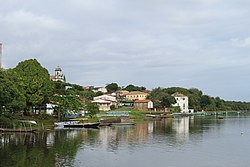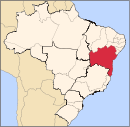Jaguaripe
Jaguaripe | |
|---|---|
Municipality | |
 View of Jaguaripe from the Jaguaripe River | |
 | |
| Country | |
| Region | Nordeste |
| State | Bahia |
| Government | |
| • mayor | Heráclito Rocha Arandas |
| Population (2020 [1]) | |
• Total | 18,981 |
| Time zone | UTC−3 (BRT) |
Jaguaripe is a municipality in the state of Bahia in the North-East region of Brazil. It covers 863.424 km2 (333.370 sq mi), and has a population of 18,981 with a population density of 18.32 inhabitants per square kilometer. Jaguaripe is located 130 km (81 mi) from the state capital of Bahia, Salvador. Jaguaripe shares a border with the municipalities of Aratuípe, Nazaré, Maragogipe, Laje, São Miguel das Matas, and Santo Antônio de Jesus. It was the first municipality created outside of Salvador, dating to 1693.[2][3]
Etymology
[edit]"Jaguaripe" comes from the Tupi language term îagûarype, meaning "in the river of jaguars" (îagûara, jaguar + 'y, river + pe, em).[4]
Location
[edit]The municipal center of Jaguaripe sits on a narrow strip of land between the Jaguaripe River and a smaller tributary, the Dona River. The location is a few kilometers from the Bay of All Saints. The municipality additionally encompasses a large rural area in the Bahian Recôncavo. Jaguripe, like São Francisco do Conde, has the seat of religious power of the municipality at its highest point, and the center of government at its lowest point near a river.[5]
History
[edit]Jaguaripe was home to speakers of Macro-Jê languages, ancient inhabitants of the Recôncavo Baiano region. The Tupi people emerged from the Amazon and expelled the Macro-Jês peoples. The Portuguese arrived in the region in 16th century, and encountered Tupinambá settlements. European colonization of Jaguaripe dates to the beginning of the 17th century under Mem de Sá (ca. 1500-1572), the 3rd General Government of Brazil. Mem de Sá, on the advice of Father Manuel da Nóbrega, directed the Jesuits to establish small Christian settlements (aldeias) to baptize and education indigenous people.[6][7]
A Jesuit mission, the Aldeia de Santa Cruz, was created on the Island of Itaparica in 1560 by Father Pedro Lírio da Gra. A large smallpox epidemic broke out between 1560 and 1568 that decimated much of the aldeia. The Jesuits decided to transfer the remnants of the Aldeia de Santa Cruz to the present-day city of Jaguaripe until the end of the plague. The aldeia subsequently became a settlement on a strip of land between the Jaguaripe River and the smaller Dona River. The Jaguaripe River extends from Nazare and Maragogipinho to the northeast, and opens into the Bay of All Saints at Itaparica Island to the east.[7]
The Portuguese established sugarcane plantations in the area by the late 16th century. The first land grant in Jaguaripe was given by governor Mem de Sa to Ana Álvares, eldest daughter of Caramuru. The settlement was called the Arraial de Nossa Senhora da Ajuda by the early 17th century; it was elevated to the level of freguesia, or civil parish, by Bishop Dom Constantino Barrada (1550-1618), in 1613. The Jaguaripe region was home to a messianic movement called the Santidade de Jaguaripe. It developed in the 1580s among indigenous peoples due to enslavement and forced settlement. Enslaved Africans joined the movement, which spread across Bahia and Pernambuco. The Santidade de Jaguaripe was violently suppressed in the early 17th century.[8]
It was raised to village level in December 1697 under Dom João de Lencastro (1646-1707), a Portuguese colonial administrator. Jaguaripe, once a center of sugarcane production and timber extraction, diminished in importance as other cities in the Recôncavo increased. It was elevated to municipal level in 1899.[5][7][9]
Historic structures
[edit]Jaguaripe is home to numerous colonial-period historic structures, some designated Brazilian national state monuments by the National Institute of Historic and Artistic Heritage (IPHAN).
- Parish Church of Our Lady of Help (Igreja Matriz de Nossa Senhora da Ajuda)
- Church of Our Lady the Mother of God (Igreja de Nossa Senhora da Madre de Deus)
- Church of Our Lady of the Rosary (Igreja de Nossa Senhora do Rosário)
- Town Hall and Prison of Jaguaripe (Casa da Câmara e Cadeia)
- Magistrate's House (Casa do Ouvidor)
See also
[edit]References
[edit]- ^ IBGE 2020
- ^ "Jaguaripe" (in Portuguese). Brasília, Brazil: Instituto Brasileiro de Geografia e Estatística. 2021. Retrieved 2021-06-28.
- ^ "Ranking decrescente do IDH-M dos municípios do Brasil" (in Portuguese). Atlas do Desenvolvimento Humano, Programa das Nações Unidas para o Desenvolvimento (PNUD). 2000. Archived from the original on October 3, 2009. Retrieved December 17, 2009.
- ^ Eduardo de Almeida Navarro (2013). Dicionário de Tupi Antigo: a língua indígena clássica do Brasil: vocabulário português-tupi e dicionário tupi-português, tupinismos no português do Brasil, etimologias de topônimos e antropônimos de origem tupi (in Portuguese and tup) (1st ed.). São Paulo: Global Editora. p. 579. ISBN 978-85-260-1933-1. OCLC 869424504. OL 31098498M. Wikidata Q107351543.
{{cite book}}: CS1 maint: unrecognized language (link) - ^ a b Azevedo, Paulo Ormindo de (2013). "Jaguaripe". Lisbon, Portugal: Heritage of Portuguese Influence/Património de Influência Portuguesa. Retrieved 2021-07-01.
- ^ Carlos Bresciani (2000), A primeira evangelizaçao das aldeias ao redor de Salvador, Bahia: 1549-1569 (in Portuguese), Salvador: Gregorio de Mattos Foundation, pp. 83–90, OCLC 800023551, Wikidata Q107363984
- ^ a b c IPAC-BA (in Portuguese), vol. 2 (1st ed.), Salvador: Bahia. Coordenação de Fomento ao Turismo, 1975, p. 161-162, Wikidata Q61935830
- ^ Alida C. Metcalf (1 January 1999). "Millenarian slaves? The Santidade de Jaguaripe and slave resistance in the Americas". The American Historical Review. 104 (5): 1531–1559. doi:10.2307/2649350. ISSN 0002-8762. JSTOR 2649350. PMID 19291894. Wikidata Q46500074.
- ^ Francisco Vicente Vianna (1893), Memoria sobre o Estado da Bahia (in Portuguese), Salvador: Diário da Bahia, p. 516-519, Wikidata Q106036478



